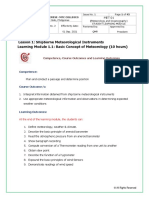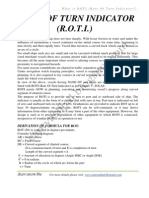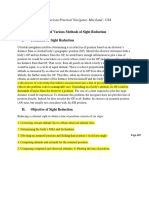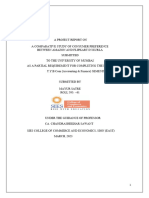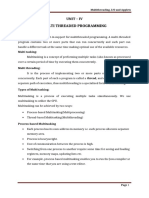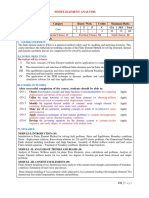Distance Speed Time
Uploaded by
Uma MaheswararaoDistance Speed Time
Uploaded by
Uma MaheswararaoTIME, SPEED, AND DISTANCE
All piloting and maneuvering solutions contain three factors: time, speed, and distance. Understanding how
to calculate time, speed and distance questions is essential for safe navigation.
10 knots is a short way to say 10 nautical miles per hour. A nautical mile is longer than a statute mile
which is used for navigating on land. One nautical mile equals 1.15 statue miles. If it takes someone an
hour to travel 45 miles, they must have averaged 45 mph. The same concept applies to a vessel. A ship
averaging 20 knots would go 20 nautical miles in one hour or 200 miles in 10 hours.
Two different methods are commonly used to solve the same problem. The best is the one that is easiest
for you to use and remember. Method #1 seems to be the most widely used method.
With these formulas memorized, you can easily solve time, speed and distance problems with paper and
pencil or a simple calculator. A nautical slide rule is not always readily available or as accurate as using
the formula.
D Distance in nautical miles
S Speed in knots
T Time in minutes
These methods for computing time, speed, or distance requires that you know two factors in order to
determine the third:
Method # 1
D = S x T 60
S = D x 60 T
T = D x 60 S
As an aid, use this diagram:
60
D
S T
A suggested memory aid is: 60 D Street.
First multiply the two known factors that are on the same line, then divide by the third known factor.
1. Before calculating, always convert hours and minutes to total minutes
(Example: 01:45 = 105 total minutes)
2. Cover the unknown with your finger.
3. Multiply by the opposites on the same line in the diagram.
4. Divide by the remaining figure on the diagram for the answer.
5. After solving for time, convert total minutes to hours and minutes (Example: 85 minutes = 01:25)
Example 1: A ship travels 7 miles in 30 minutes. What is its speed?
Solution:
S = D x 60 = 7 x 60 = 420 = 14 knots
T 30 30
Example 2: A ships speed is 15 knots. How far will it travel in 20
minutes?
Solution:
D = S x T = 20 x 15 = 300 = 5 Miles
60 60 60
Example 3: A ships speed is 8 knots. How long will it take for it to
travel 6 miles?
Solution:
T = D x 60 = 6 x 60 = 360 = 45 minutes
S 8 8
Method # 2
Time is in hours and tenths of an hour
D = S x T
S = D T
T = D S
When using this method, minutes need to be converted to tenths of an hour. For instance, 30 minutes
divided by 60 = 0.5 or half an hour.
Sometimes tenths of an hour needs to be converted to minutes. 1.42 hours equals 1 hour 25 minutes.
( .42 X 60 =25.2 rounded to 25 minutes )
You might also like
- Lesson 1: Shipborne Meteorological Instruments Learning Module 1.1: Basic Concept of Meteorology (10 Hours)No ratings yetLesson 1: Shipborne Meteorological Instruments Learning Module 1.1: Basic Concept of Meteorology (10 Hours)45 pages
- Ecdis: Electronic Chart Display and Information System100% (1)Ecdis: Electronic Chart Display and Information System23 pages
- Ecdis: Electronic Chart Display and Information System100% (1)Ecdis: Electronic Chart Display and Information System47 pages
- Bridge Control Failure Check List: Company Forms and Check ListsNo ratings yetBridge Control Failure Check List: Company Forms and Check Lists1 page
- Seam 5 Topic 1 Principles of Ship HandlingNo ratings yetSeam 5 Topic 1 Principles of Ship Handling16 pages
- Unit 10 Charts, Datum and Compass Corrections: StructureNo ratings yetUnit 10 Charts, Datum and Compass Corrections: Structure18 pages
- MGN 63 Use of Electronic Aids To NavigationNo ratings yetMGN 63 Use of Electronic Aids To Navigation9 pages
- 1 Point: Appraisal Planning, Execution, Monitoring 4 Points AnswerNo ratings yet1 Point: Appraisal Planning, Execution, Monitoring 4 Points Answer5 pages
- Only For Examination Purposes GMDSS: Global Maritime Distress and Safety SystemNo ratings yetOnly For Examination Purposes GMDSS: Global Maritime Distress and Safety System13 pages
- 08 - Navigation Safety 2 - Principles To Be Observed in Keeping A Navigational Watch100% (1)08 - Navigation Safety 2 - Principles To Be Observed in Keeping A Navigational Watch49 pages
- Terrestrial Navigation Item Analysis 1: Identify The Choice That Best Completes The Statement or Answers The QuestionNo ratings yetTerrestrial Navigation Item Analysis 1: Identify The Choice That Best Completes The Statement or Answers The Question33 pages
- Tacaldo Learning Module NAV 5 - Operational Use of RADAR - ARPA LO No. 2.10 LO No. 2.112100% (1)Tacaldo Learning Module NAV 5 - Operational Use of RADAR - ARPA LO No. 2.10 LO No. 2.11212 pages
- TOPIC IMO Performance Standards ECDIS MSC 232 (100% (1)TOPIC IMO Performance Standards ECDIS MSC 232 (6 pages
- Nav-2 Finals Coverage: Traffic Lanes and Separation Zones100% (3)Nav-2 Finals Coverage: Traffic Lanes and Separation Zones17 pages
- Gapoy, Frednixen B. Learning - Module - NAV - 5 - Operational - Use - of - RADAR - ARPA - LO - No. - 1.3100% (1)Gapoy, Frednixen B. Learning - Module - NAV - 5 - Operational - Use - of - RADAR - ARPA - LO - No. - 1.319 pages
- COMPETENCE: Respond To A Distress Signal KUP: Knowledge of The Contents of The100% (2)COMPETENCE: Respond To A Distress Signal KUP: Knowledge of The Contents of The34 pages
- Nautical Jobs Hunter: First Steps Towards a Hospitality Career at Sea or on LandFrom EverandNautical Jobs Hunter: First Steps Towards a Hospitality Career at Sea or on LandNo ratings yet
- Computer Training For Spms of B & C Class Sos Exercises Exercise 1 - Routine Operations in Point of Sale ModuleNo ratings yetComputer Training For Spms of B & C Class Sos Exercises Exercise 1 - Routine Operations in Point of Sale Module41 pages
- Kinds of Postal Articles: First 9 Come Under & 10 Under100% (1)Kinds of Postal Articles: First 9 Come Under & 10 Under28 pages
- Design and Implementation of A Microcontroller Development Kit For STEM EducationNo ratings yetDesign and Implementation of A Microcontroller Development Kit For STEM Education11 pages
- 61 - TYBAF - A Comparative Study of Consumer Preference Between Amazon and Flipkart - Mayur Satre - Research ProjectNo ratings yet61 - TYBAF - A Comparative Study of Consumer Preference Between Amazon and Flipkart - Mayur Satre - Research Project97 pages
- NetApp AltaVault Cloud Integrated Storage PosterNo ratings yetNetApp AltaVault Cloud Integrated Storage Poster4 pages
- All in One Source For Grade 11 (2nd Sem)No ratings yetAll in One Source For Grade 11 (2nd Sem)1,561 pages
- Online Recruitment Application (Ora) Powerd by NicNo ratings yetOnline Recruitment Application (Ora) Powerd by Nic1 page
- Catalog M-Y - I - N Di Mao Qu - N T - NG Minicap Flex Piercing CN030913No ratings yetCatalog M-Y - I - N Di Mao Qu - N T - NG Minicap Flex Piercing CN0309132 pages
- Schneider Electric Altivar-Process-ATV900 ATV930C16N4No ratings yetSchneider Electric Altivar-Process-ATV900 ATV930C16N413 pages
- FPGA Design of A Fast 32-Bit Floating PointNo ratings yetFPGA Design of A Fast 32-Bit Floating Point3 pages
- Chemical Process Calculation by K Ashokan-1No ratings yetChemical Process Calculation by K Ashokan-1256 pages
- 2024 - Personalized Equalization of Sound Pressure at Eardrum With Insert EarbudsNo ratings yet2024 - Personalized Equalization of Sound Pressure at Eardrum With Insert Earbuds8 pages
